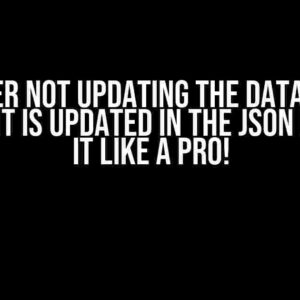Are you tired of dealing with mysterious HTTP proxy errors in your Golang application? Do you find yourself stuck in a debugging loop, wondering what’s going on behind the scenes? Worry no more! In this comprehensive guide, we’ll walk you through the process of checking for HTTP proxy errors in Golang, covering the why, the how, and the what-to-do-when-it-all-goes-wrong.
Why Do HTTP Proxy Errors Occur in Golang?
Before we dive into the solution, let’s take a step back and understand why HTTP proxy errors occur in Golang in the first place. There are several reasons why your Golang application might encounter HTTP proxy errors:
- Misconfigured proxy settings : If your proxy settings are incorrect or mismatched, your requests will fail to reach their intended destinations.
- Network connectivity issues : Poor network connectivity, firewalls, or router configurations can block your requests, leading to proxy errors.
- Proxy server issues : Proxy servers can be down, slow, or unresponsive, causing your requests to time out or fail.
- Authentication and authorization problems : If your credentials are incorrect or lacking, you’ll encounter proxy errors.
- Content filtering and restrictions : Certain proxy servers might block specific content, leading to errors.
How to Check for HTTP Proxy Errors in Golang
Now that we’ve covered the reasons behind HTTP proxy errors, let’s move on to the solution. Here’s how you can check for HTTP proxy errors in your Golang application:
Method 1: Using the net/http Package
The net/http package provides a built-in way to handle HTTP requests and proxy errors. You can use the http.Client struct to create a custom client that checks for proxy errors:
package main
import (
"fmt"
"net/http"
)
func main() {
client := &http.Client{
Transport: &http.Transport{
Proxy: http.ProxyURL(&url.URL{
Scheme: "http",
Host: "your-proxy-url:8080",
}),
},
}
req, err := http.NewRequest("GET", "https://example.com", nil)
if err != nil {
fmt.Println(err)
return
}
resp, err := client.Do(req)
if err != nil {
fmt.Println(err)
return
}
defer resp.Body.Close()
if resp.StatusCode != http.StatusOK {
fmt.Println("Error:", resp.Status)
return
}
fmt.Println("Success:", resp.Status)
}
Method 2: Using the gorequest Package
The gorequest package provides a convenient way to send HTTP requests and handle proxy errors. You can use the New() function to create a new request instance:
package main
import (
"fmt"
"github.com/parnurzeal/gorequest"
)
func main() {
req := gorequest.New()
_PROXY_URL := "http://your-proxy-url:8080"
req.Proxy(_PROXY_URL).Get("https://example.com")
if req.Error != nil {
fmt.Println(req.Error)
return
}
fmt.Println(req.StatusCode)
}
Handling HTTP Proxy Errors in Golang
Now that we’ve covered how to check for HTTP proxy errors in Golang, let’s talk about how to handle them. Here are some best practices to keep in mind:
Logging and Error Reporting
When dealing with proxy errors, it’s essential to log and report errors effectively. This helps you identify the root cause of the issue and take corrective action:
log.Println("Proxy error:", err)
fmt.Println("Proxy error:", err)
Rerouting Requests
If your proxy server is down or unresponsive, you can reroute your requests to a backup proxy or even skip the proxy altogether:
client := &http.Client{
Transport: &http.Transport{
Proxy: nil, // skip proxy
},
}
Implementing Retries and Backoff Strategies
When dealing with intermittent proxy errors, it’s a good idea to implement retries and backoff strategies to ensure your requests eventually succeed:
func retryRequest(req *http.Request, retries int) (*http.Response, error) {
for i := 0; i < retries; i++ {
resp, err := client.Do(req)
if err != nil {
time.Sleep(2 * time.Second) // backoff
continue
}
return resp, err
}
return nil, errors.New("max retries exceeded")
}
Common HTTP Proxy Error Codes and Messages
When checking for HTTP proxy errors, you might encounter specific error codes and messages. Here are some common ones:
| Error Code | Error Message |
|---|---|
| 407 | Proxy Authentication Required |
| 502 | Bad Gateway |
| 503 | Service Unavailable |
| 504 | Gateway Timeout |
By understanding these error codes and messages, you can take targeted action to resolve the underlying issue.
Conclusion
In this comprehensive guide, we’ve covered the why, the how, and the what-to-do-when-it-all-goes-wrong of checking for HTTP proxy errors in Golang. By following these best practices and implementing effective error handling strategies, you’ll be well-equipped to handle even the most challenging proxy errors.
Remember, debugging is an essential part of software development, and with the right tools and knowledge, you can conquer even the most frustrating HTTP proxy errors in Golang.
Happy coding!
Frequently Asked Question
Get ready to debug like a pro! Here are the top questions and answers about checking for HTTP proxy errors in Golang:
Q: How do I detect if a proxy error occurred in a Golang HTTP request?
You can check the error returned by the `Get()`, `Post()`, or other HTTP request methods. If the error is of type `*url.Error`, you can cast it to `*url.Error` and check the `Err` field. If it’s not nil, it indicates a proxy error.
Q: How do I get more information about the proxy error in Golang?
You can use the `Err` field of the `*url.Error` type to get more information about the error. For example, you can use the `Error()` method to get the error message as a string.
Q: Can I set a timeout for the proxy request in Golang?
Yes, you can set a timeout using the `Timeout` field of the `http.Client` struct. For example, `client.Timeout = 10 * time.Second` sets a 10-second timeout.
Q: How do I bypass the proxy for local requests in Golang?
You can use the `Proxy` field of the `http.Transport` struct and set it to `nil` for local requests. This will bypass the proxy for those requests.
Q: Can I use a custom proxy URL in Golang?
Yes, you can use a custom proxy URL by setting the `Proxy` field of the `http.Transport` struct to a `url.URL` object pointing to your custom proxy URL.





